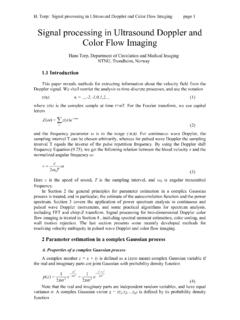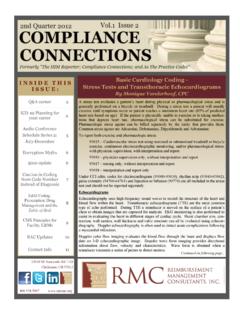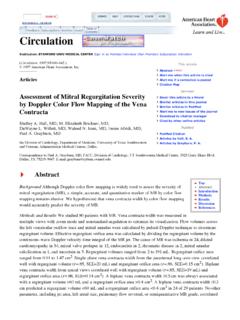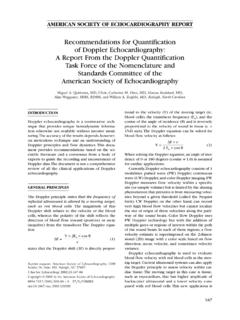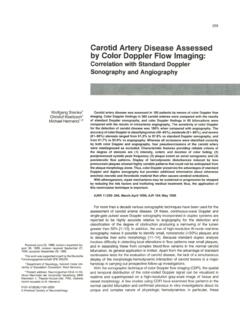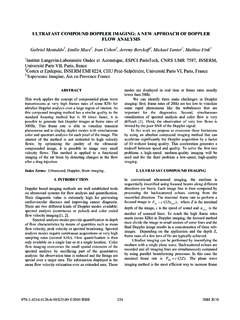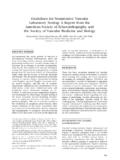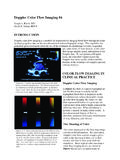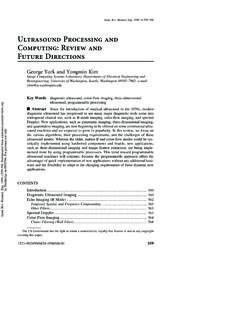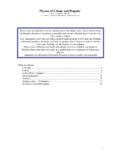Transcription of Autocorrelation Techniques in Color Flow Imaging: Signal ...
1 604 IEEE TRANSACTIONS ON ULTRASONICS. FERROELECTRICS, AND FREQUENCY CONTROL, VOL. 41, NO. 5, SEFTEMBER 1994 Autocorrelation Techniques in Color Flow imaging : Signal Model and Statistical Properties of the Autocorrelation Estimates Hans Torp, Member, IEEE, Kjell Kristoffersen, and Bjom A. J. Angelsen, Senior Member, IEEE Abstract-A review of the scattering theory for moving blood, and a model for the Signal in a multigated pulsed wave doppler system is presented. The model describes the relation between a general time-variable velocity field and the Signal correlation in space and time, including the effect of movement of the ultrasonic beam for Color flow imaging systems with mechanical scanning.
2 In the case of a constant and rectilinear velocity field, a parametric model for the Autocorrelation function is deduced. General formulas for a full second order characterization of the set of Autocorrelation estimates, with arbitrary lags in the spatial and temporal directions, are developed. The formulas are applied to the parametric model, and numerical results for the estimator variance are presented. A qualitative evaluation of the theoretical results has been performed by offline-processing of 2-D doppler signals from a Color flow imaging scanner. The benefit of spatial and temporal averaging is demonstrated by using different averaging filters to the same set of recorded data.
3 G A NOMENCLATURE Wave number Velocity field as a function of space T and time t. Spherical coordinates with center in the transducer rotation-center and scanning plane in 4) = 0. Spherical components of the velocity field. Radial range gate function Pulse repetition time interval. Blood cell fluctuation, spectral density. Displacement of a fluid element during time r Radial component of the displacement C. Distance between the range gates in the radial direction. Radial length of the sample volume. Radial transit time. Lateral transit time. Transversal transit time.
4 Transducer rotation angular velocity. doppler frequency shift Manuscript received July l, 1993; revised March 14, 1994; accepted March 16, 1994. This work was supported by the Norwegian Research Council. H. Torp and B. A. J. Angelsen are with the Department of Biomedical Engineering, Medical Technical Center, N-7005 Trondheirn, Norway. K. Kristoffersen is with Vingmend Sound Research Department, Vollsveien 13C, N-l324 Lysaker, Norway. IEEE Log Number 9403352. Wd = 2'TTfd Normalized angular doppler frequency shift 69 Convolution operator R(n, m) Autocorrelation function for the doppler R(n, m) Autocorrelation estimate of R(n, m).
5 4(n, m) Phase of the complex Autocorrelation 4% m) 2-D smoothing filter coefficients. R(n2, m21 wn2, m2) Signal with lag n in radial direction, and lag m in temporal direction. estimate R(n, m) C,(nl, ml, n2,mz) Covariance between R(n1, ml)* and C(n1, ml, n2! m2) Covariance between R(n1, ml) and A I. INTRODUCTION UTOCORRELATION Techniques for two- dimensional (2-D) velocity imaging were first developed for weather Radar applications [l], and later applied to blood velocity imaging [2]. Originally, each range cell along the beam was processed individually, to estimate the Signal parameters.
6 More recently algorithms using data from several range cells have been presented [3], [4]. In this case the movement of the blood between the range cells has an influence on the statistical properties of the estimates. It is therefore convenient to model the received Signal as a 2-D complex Gaussian process, described by an Autocorrelation function with lag in both the radial (along the beam), and the temporal directions. For Color flow imaging with a mechanical sector scan, the movement of the ultrasonic beam over the sector must be taken into account.
7 This movement causes rapid changes in the Signal properties as the beam sweeps over different flow-patterns in the body. To maintain spatial resolution, only a small number of Signal samples can be used for calculation of the blood flow parameters at each point of the sector, giving Autocorrelation estimates with a high fractional variance. A number of authors have modeled the doppler Signal from moving blood as a zero-mean Gaussian process, with power spectrum equal to a blurred version of the velocity distribution inside the sample volume [5]-[7].
8 To justify the Gaussian assumption, the received Signal is modeled as a sum of independent Signal components from a large number of point-scatterers, each contributing a slightly modified replica 0885-3010/94$ Q 1994 IEEE TORP er al.: Autocorrelation Techniques IN Color imaging 605 of the transmitted pulse, with a delay according to the distance from the transducer. In [4] a scattering model for blood is given, based on a random continuum model for the red blood cell distribution, which leads to an expression for the Autocorrelation function of the received Signal .
9 The random continuum approach has also been used in a recent work of MO et al. [S] to characterize the power spectrum in continuous wave doppler . Bonnefous et al. [3] describe the cross correlation between the consecutive received RF signals in a Color flow mapping system due to the movement of the red blood cells. Ferrara et al. [4], describe the received Signal as a one-dimensional (l-D) complex Gaussian process, and show how the Autocorrelation function for a uniform velocity field is nearly periodic, with period close to the pulse repetition time.
10 In [9] their model is extended to account for frequency dependent scattering and attenuation. This paper is organized as follows. In Section I1 and 111, the Autocorrelation function for the Signal is described for a general velocity field, based on the random continuum scattering model for moving blood. Section IV describes the rectilinear flow situation, where the magnitude of the complex Autocorrelation function gets a Gaussian form, described by three parameters. Section V contains general formulas for the covariance of the set of Autocorrelation estimates.
